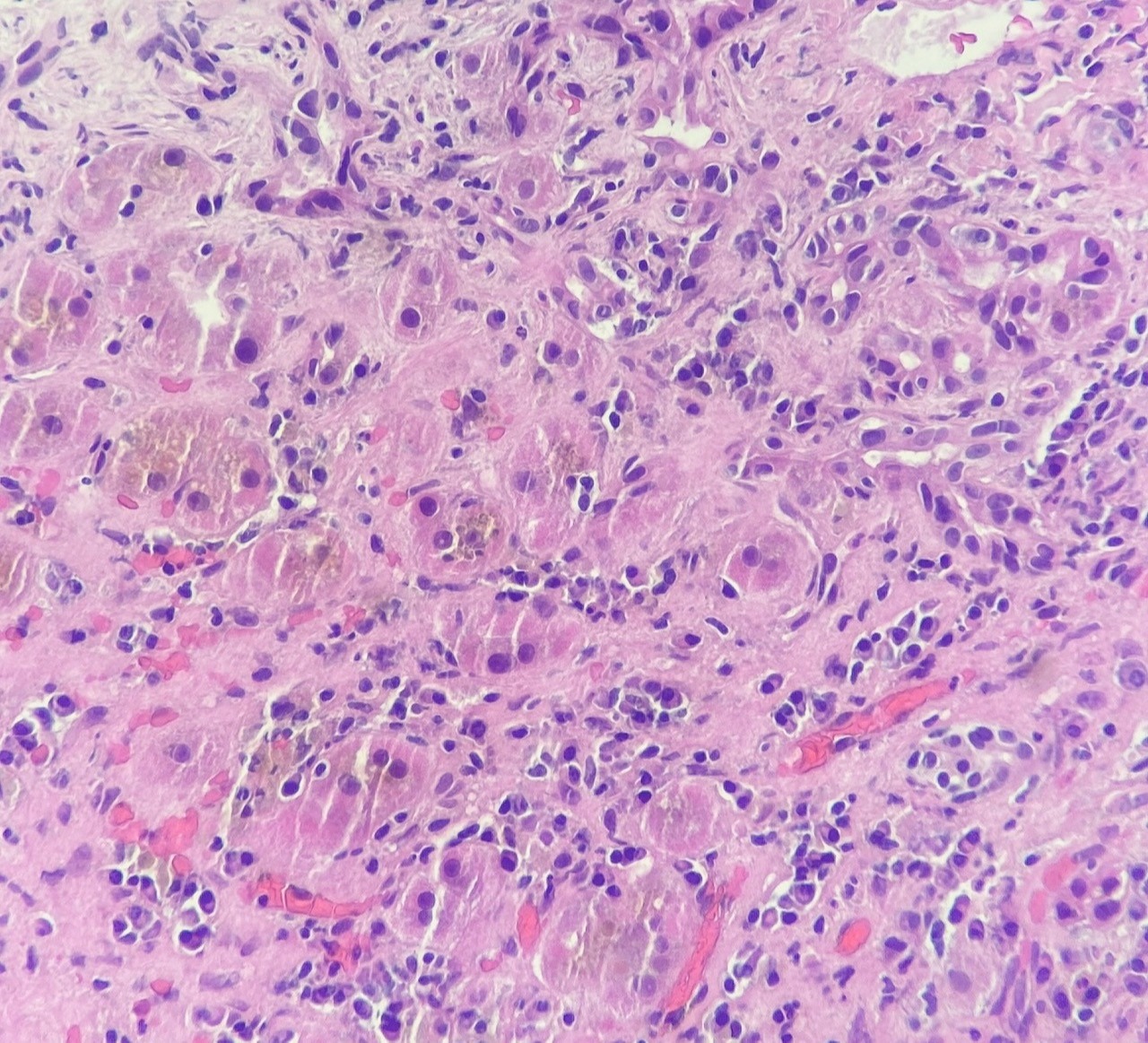Back


Poster Session C - Monday Afternoon
Category: Liver
C0581 - Drug-Induced Autoimmune-Like Hepatitis Secondary to Gymnema Sylvestre
Monday, October 24, 2022
3:00 PM – 5:00 PM ET
Location: Crown Ballroom

Has Audio

Alejandro J. Loyola-Velez, MD
VA Caribbean Medical Center
San Juan, PR
Presenting Author(s)
Alejandro J. Loyola-Velez, MD1, Stephanie Ortiz -Troche, MD2, Carolina S. Diaz-Loza, MD2, Natali M. Perez-Cruz, MD2, Kathia E. Rosado-Orozco, MD3, Karla N. Colon-Torres, MD2, Jose Martin Ortiz, MD, FACG2
1VA Caribbean Medical Center, San Juan, Puerto Rico; 2VA Caribbean Health Care System, San Juan, Puerto Rico; 3VAMC Caribbean, San Juan, Puerto Rico
Introduction: The use of complementary and alternative medicine remains attractive despite not undergoing the same rigorous evaluations as the Federal Drug Administration-Approved medications. Gymnema sylvestre (GS) is an herbal supplement used for its hypoglycemic effects in patients with diabetes mellitus (DM), despite little evidence supporting its benefits. However, we present a patient who developed acute liver injury, via an autoimmune modality, while initiating therapy with GS.
Case Description/Methods: A 67-year-old male with a history of hypertension and type II DM, who arrived at the Emergency Department with jaundice and acute elevation of liver enzymes. Laboratory workup was remarkable for the marked elevation of liver function tests (LFTs), with AST 2247 U/L and ALT 2100 U/L, elevated total bilirubin levels at 19.8 mg/dL with direct bilirubin predominance. R-factor at that time was 16, suggestive of hepatocellular injury. Further workup including urine toxicology, anti-mitochondrial antibody, HIV, CMV, EBV, HSV, and ceruloplasmin levels were unremarkable. However, the anti-smooth muscle antibody and HAV antibody were positive. Abdominopelvic MRI demonstrated absence of hepatic pathology. Drug-induced liver injury (DILI) was suspected from GS, which the patient was taking for glucose control. In addition, IgG and IgA levels were found to be elevated, at 2952 and 663 respectively, resulting in an autoimmune hepatitis score of 4. LFTs started to improve after the discontinuation of GS. Interventional Radiology was consulted for liver biopsy, with findings of necrosis and a marked inflammatory infiltrate pattern of injury, as is seen in autoimmune hepatitis or DILI. High-dose steroid therapy was started along with initiating workup for liver transplant.
Discussion: GS is commonly used for glucose control in patients with DM, but its reportedly beneficial effects have only been supported in a small amount of non-randomized trials. Although LFTs were on a downward trend after discontinuation of the offending agent, the patient’s synthetic liver function continued to deteriorate. Biopsy and lab work were suggestive of classic autoimmune hepatitis (AIH) vs drug-induced autoimmune-like hepatitis (DI-AIH). Prednisone was started and, considering poor prognostic factors on histology (necrosis), workup for liver transplant was initiated. Steroid therapy response may determine if the patient’s acute liver injury is due to AIH or DI-AIH. Nevertheless, GS played a leading role in this patient’s disease process.

Disclosures:
Alejandro J. Loyola-Velez, MD1, Stephanie Ortiz -Troche, MD2, Carolina S. Diaz-Loza, MD2, Natali M. Perez-Cruz, MD2, Kathia E. Rosado-Orozco, MD3, Karla N. Colon-Torres, MD2, Jose Martin Ortiz, MD, FACG2. C0581 - Drug-Induced Autoimmune-Like Hepatitis Secondary to Gymnema Sylvestre, ACG 2022 Annual Scientific Meeting Abstracts. Charlotte, NC: American College of Gastroenterology.
1VA Caribbean Medical Center, San Juan, Puerto Rico; 2VA Caribbean Health Care System, San Juan, Puerto Rico; 3VAMC Caribbean, San Juan, Puerto Rico
Introduction: The use of complementary and alternative medicine remains attractive despite not undergoing the same rigorous evaluations as the Federal Drug Administration-Approved medications. Gymnema sylvestre (GS) is an herbal supplement used for its hypoglycemic effects in patients with diabetes mellitus (DM), despite little evidence supporting its benefits. However, we present a patient who developed acute liver injury, via an autoimmune modality, while initiating therapy with GS.
Case Description/Methods: A 67-year-old male with a history of hypertension and type II DM, who arrived at the Emergency Department with jaundice and acute elevation of liver enzymes. Laboratory workup was remarkable for the marked elevation of liver function tests (LFTs), with AST 2247 U/L and ALT 2100 U/L, elevated total bilirubin levels at 19.8 mg/dL with direct bilirubin predominance. R-factor at that time was 16, suggestive of hepatocellular injury. Further workup including urine toxicology, anti-mitochondrial antibody, HIV, CMV, EBV, HSV, and ceruloplasmin levels were unremarkable. However, the anti-smooth muscle antibody and HAV antibody were positive. Abdominopelvic MRI demonstrated absence of hepatic pathology. Drug-induced liver injury (DILI) was suspected from GS, which the patient was taking for glucose control. In addition, IgG and IgA levels were found to be elevated, at 2952 and 663 respectively, resulting in an autoimmune hepatitis score of 4. LFTs started to improve after the discontinuation of GS. Interventional Radiology was consulted for liver biopsy, with findings of necrosis and a marked inflammatory infiltrate pattern of injury, as is seen in autoimmune hepatitis or DILI. High-dose steroid therapy was started along with initiating workup for liver transplant.
Discussion: GS is commonly used for glucose control in patients with DM, but its reportedly beneficial effects have only been supported in a small amount of non-randomized trials. Although LFTs were on a downward trend after discontinuation of the offending agent, the patient’s synthetic liver function continued to deteriorate. Biopsy and lab work were suggestive of classic autoimmune hepatitis (AIH) vs drug-induced autoimmune-like hepatitis (DI-AIH). Prednisone was started and, considering poor prognostic factors on histology (necrosis), workup for liver transplant was initiated. Steroid therapy response may determine if the patient’s acute liver injury is due to AIH or DI-AIH. Nevertheless, GS played a leading role in this patient’s disease process.

Figure: Liver biopsy shows portal inflammation with marked increase in plasma cells. Marked interface activity is seen with areas of necrosis
Disclosures:
Alejandro Loyola-Velez indicated no relevant financial relationships.
Stephanie Ortiz -Troche indicated no relevant financial relationships.
Carolina Diaz-Loza indicated no relevant financial relationships.
Natali Perez-Cruz indicated no relevant financial relationships.
Kathia Rosado-Orozco indicated no relevant financial relationships.
Karla Colon-Torres indicated no relevant financial relationships.
Jose Martin Ortiz indicated no relevant financial relationships.
Alejandro J. Loyola-Velez, MD1, Stephanie Ortiz -Troche, MD2, Carolina S. Diaz-Loza, MD2, Natali M. Perez-Cruz, MD2, Kathia E. Rosado-Orozco, MD3, Karla N. Colon-Torres, MD2, Jose Martin Ortiz, MD, FACG2. C0581 - Drug-Induced Autoimmune-Like Hepatitis Secondary to Gymnema Sylvestre, ACG 2022 Annual Scientific Meeting Abstracts. Charlotte, NC: American College of Gastroenterology.
